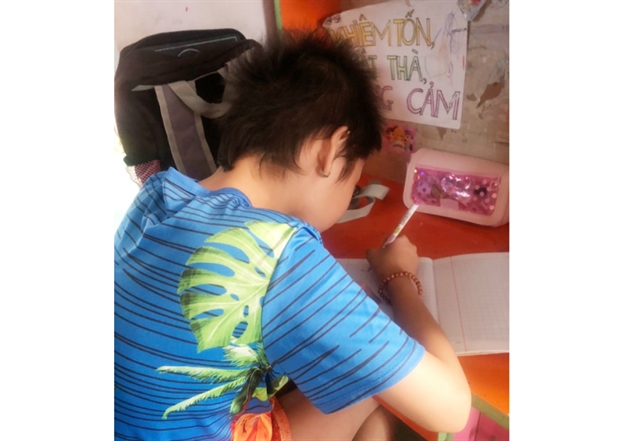 Society
Society


|
| Dr Tô Thùy Nhi from HCM City’s Children's Hospital No 2’s Department of haematology-oncology examines a child with ovarian cancer. Photo tuoitre.vn |
HÀ NỘI — Hà, a 12-year-old girl from southern Bến Tre Province, has lost one ovary and suffered painful complications after doctors discovered she had a malignant ovarian tumour about 25 cm in size.
Hà is among the rare children suffering from ovarian cancer.
Last summer, Phương, Hà's mother, noticed that her daughter had gained weight and her stomach was enlarged. At first, she thought Hà was going through puberty but Hà’s stomach was abnormally large, hard and inelastic.
Phương took the daughter to Bến Tre General Hospital. The doctors diagnosed the girl as having a very large ovarian tumour and transferred her to HCM City’s Children's Hospital No 2 for treatment.
After having many tests, the doctor concluded that the girl had a giant ovarian malignancy, which occupied her entire abdomen. She was at stage 3 of ovarian cancer.
Phương did not tell the girl about her illness so that she wouldn’t feel depressed.
Hà underwent surgery to remove the right ovary with the tumour and large omentum, then transferred to HCM City Oncology Hospital for chemotherapy.
Her body was weak due to surgery, so the treatment process was difficult and took longer than usual.
Her treatment regimen included four periods of chemotherapy planned to last for three months. However, the treatment lasted for four months.
Hà’s body reacted when she entered the first treatment. Her body suddenly stiffened, convulsed, and her teeth bit into her tongue and spurted blood.
The doctor said Hà suffered from the side effect of chemicals that lowered calcium and potassium in the blood, leading to severe pain with vomiting and convulsions.
The convulsions continued, sometimes several times a day. Hà also suffered serious complications such as electrolyte disturbances, causing acute disturbances in consciousness and brain abscesses, requiring emergency treatment.
Once with a severe blood infection, Hà had to go to Children's Hospital No 2 for a partial blood transfusion, and the chemotherapy was interrupted.
Hà lost more than six kilos and weighed less than 20 in total.
Last August, Hà said she didn’t want to be treated and wanted to go home. Her mother decided to take Hà back to her hometown for a two-week break before starting the second chemo.
This time, Hà completed the required therapy and is currently in stable condition.

|
| Hà, a 12-year-old girl in southern Bến Tre Province, resumes her study after completing treatment for ovarian cancer. Photo courtesy of Hà's family |
Dr Nguyễn Phương Nguyên from the Pediatric Oncology Department under HCM City’s Children’s Hospital No 2 said ovarian cancer was in the germ cell group accounting for about 15 per cent of all cancers in children.
The cause of this cancer is still unknown.
The hospital receives about seven children with ovarian malignancy every year. All cases have to remove one ovary, facing a high risk of death when the tumour invades other organs.
Dr Tô Thùy Nhi from the hospital’s Department of haematology-oncology said that ovarian malignancies in girls were common in groups under four-years-old and adolescents.
They are germ cell cancers so they don't have any typical signs.
Nhi said that the cause of the disease was mainly due to genetic factors, namely a duplication or deletion of chromosomes.
She said each woman had two ovaries. Most malignancies of the ovary are unilateral and the ovary containing the tumour requires radical resection. The preservation of reproductive function requires keeping the remaining ovary.
Early detection of the disease in children is difficult because the symptoms are not clear. When there are any abnormal changes in the child, especially in the abdomen, parents need to take their child to the hospital immediately.
When the child is in the treatment phase, it is necessary to follow the correct treatment regimen and re-examine them on time.
In Hà’s case, the doctors said no cancer cells had been recorded in her body so far, and she had won the most difficult battle. Hà needs to go to hospital for a follow-up appointment and will be cured if the disease doesn’t re-occur in the next five years. — VNS